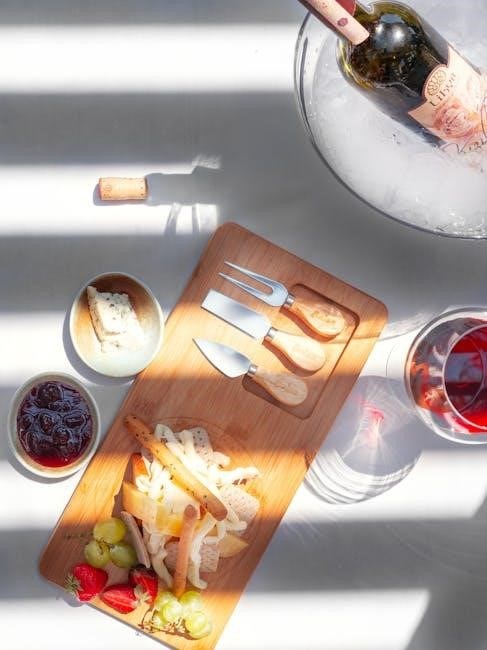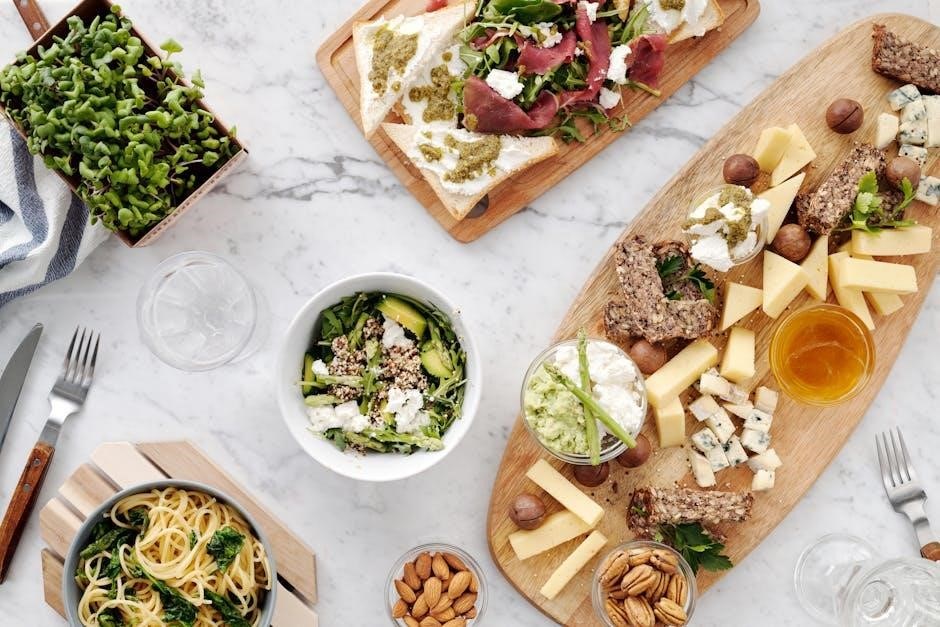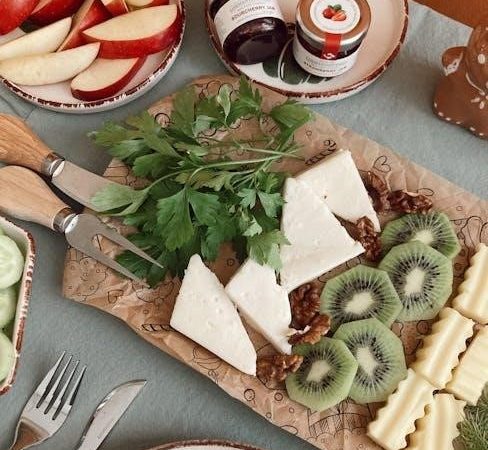Cheese knives are essential tools designed for cutting and serving various types of cheese, enhancing both presentation and the dining experience with their unique designs and craftsmanship.

Types of Cheese Knives
Types of cheese knives include soft cheese knives with perforated blades, hard cheese knives with sturdy constructions, offset knives for precision, and cleavers for robust cheeses, each designed for specific needs.
Soft Cheese Knives
Soft cheese knives are designed for delicate cheeses like Brie, Camembert, and Feta, featuring thin, flexible blades to prevent breaking or tearing the cheese. Their perforated or hollow-ground edges reduce sticking, ensuring clean slices. These knives are ideal for soft, spreadable cheeses, allowing for precise control and elegant presentation. The blade’s flexibility helps navigate the creamy texture without damaging the cheese, making them indispensable for charcuterie boards and cheese platters. Whether you’re serving soft-ripened or fresh cheeses, these knives provide the perfect balance of functionality and style, enhancing your culinary experience. Their unique design ensures that every slice is effortless and visually appealing, making them a must-have for any cheese enthusiast.
Hard Cheese Knives
Hard cheese knives are crafted to handle firm and aged cheeses like Parmesan, Cheddar, and Gouda, featuring robust, rigid blades that withstand dense textures. Their sharp, straight edges allow for clean, precise cuts, while the sturdy construction ensures durability. These knives often include features like double handles or reinforced tips to exert extra pressure when cutting through hard rinds or crystalline structures. Designed for cheeses that require force, hard cheese knives are essential for serving robust varieties without breaking or crumbling the cheese. Their solid build and sharpness make them ideal for both slicing and portioning, ensuring a smooth and efficient experience. Whether it’s a aged Parmesan or a firm Gouda, these knives deliver precise results, making them a vital tool for any cheese lover.
Offset Cheese Knives
Offset cheese knives are designed with a uniquely angled or curved blade, providing optimal control and precision when cutting through various cheeses. Their offset design allows for even pressure distribution, making it easier to slice both soft and medium-hard cheeses without breaking or tearing. These knives are particularly useful for cheeses like Brie, Camembert, and soft blues, as the curved edge glides smoothly through the texture. The ergonomic handle and balanced construction reduce fatigue during extended use, while the blade’s shape prevents the knife from sinking too deeply into soft cheeses. Offset cheese knives are versatile, durable, and a practical addition to any cheese board or charcuterie set, offering both functionality and style for a seamless dining experience. Their innovative design ensures clean cuts and effortless serving, making them a favorite among cheese enthusiasts.
Cheese Cleavers
Cheese cleavers are robust tools designed for cutting and portioning hard and aged cheeses with ease. Their broad, flat blades and sturdy construction make them ideal for cheeses like Parmesan, aged cheddar, and other firm varieties. Unlike traditional knives, cleavers often feature a two-handle design, allowing for greater leverage and control when cutting through dense textures. This design also helps prevent the cheese from crumbling or breaking unevenly. Cheese cleavers are versatile and can be used for both slicing and portioning, making them a practical addition to any cheese-serving setup. Their durability and ergonomic design ensure long-lasting performance, while their sleek appearance adds a touch of sophistication to any charcuterie board or dining table. Whether you’re serving a hard cheese or need to break down a large block, a cheese cleaver is an indispensable tool for any cheese enthusiast.
How to Choose the Right Cheese Knife
Selecting the perfect cheese knife involves considering the cheese’s texture, the knife’s design, and its material. Balance form and function to ensure a seamless cutting experience and perfect cut.
Cheese Type and Knife Pairing
Pairing the right knife with the cheese ensures an optimal cutting experience. Soft cheeses like Brie or Camembert require a knife with a thin, flexible blade and perforations to prevent sticking. For harder cheeses such as Parmesan or Cheddar, a sturdy, rigid blade with a sharp edge is ideal. Offset knives are perfect for spreading soft cheeses on crackers or bread. Blue cheeses, with their crumbly texture, benefit from a knife with a serrated edge to handle the uneven surface. Understanding the texture and density of the cheese helps in selecting the most suitable knife, ensuring a clean cut and preserving the cheese’s integrity. This thoughtful pairing elevates both the presentation and enjoyment of your charcuterie or cheese board.

Blade Characteristics for Different Cheeses
The blade of a cheese knife is tailored to the specific type of cheese it is designed to cut. Soft cheeses, such as Brie or Camembert, require a blade with small holes or perforations to prevent the cheese from sticking. These knives often have a thin, flexible edge for smooth, even cuts. Hard cheeses, like Parmesan or Cheddar, need a sturdy, rigid blade with a sharp edge to handle their dense structure. For blue cheeses, a serrated blade is ideal to navigate their crumbly, veined texture. Offset blades are useful for spreading soft cheeses onto bread or crackers. Each blade design is crafted to complement the unique characteristics of the cheese, ensuring clean cuts and preserving the cheese’s flavor and texture. This attention to blade detail enhances the overall experience of serving and enjoying cheese.
Material and Construction
Cheese knives are crafted from high-quality materials to ensure durability and performance. Stainless steel is a popular choice due to its resistance to corrosion and ease of maintenance. High-carbon steel blades are favored for their sharpness and edge retention, making them ideal for cutting hard cheeses. Handles are often made from durable materials like wood, metal, or ergonomic designs for comfort and grip. Some knives feature hollow handles or weighted constructions for better balance. The construction of these knives is designed to withstand regular use, with attention to detail in blade tangs and handle attachments for longevity. Premium sets may include additional features like riveted handles or polished finishes, enhancing both functionality and aesthetics. The right material and construction ensure that cheese knives remain a reliable and elegant addition to any charcuterie or dining setting.

Care and Maintenance of Cheese Knives
Regular cleaning with warm, soapy water and thorough drying prevents rust. Store knives separately to avoid dulling. Sharpen periodically to maintain blade efficiency and longevity.
Cleaning and Storage Tips
Proper care ensures longevity and performance of cheese knives. Clean blades with warm, soapy water, avoiding harsh chemicals or abrasive scrubbers. Dry thoroughly to prevent rust. Store knives in a protective block or sheath to maintain sharpness and avoid damage. For optimal maintenance, avoid placing knives in dishwashers, as high heat can dull edges. Regular handwashing and immediate drying are recommended. Additionally, storing knives separately prevents accidental dulling. For extra protection, consider using a soft, dry cloth to wipe down blades before storage. By following these tips, your cheese knives will remain in excellent condition, ready for your next charcuterie or cheese platter preparation.
Sharpening Cheese Knives
Sharpening cheese knives is crucial for maintaining their effectiveness and ensuring clean, precise cuts. Use a whetstone or sharpening steel to restore the blade’s edge, focusing on the desired angle for the knife type. For soft cheese knives, a sharp, fine edge is essential, while hard cheese knives may require a slightly stronger angle. Electric sharpeners can also be used, but manual methods provide better control. Sharpening should be done regularly, as dull blades can tear cheese or require excessive pressure. After sharpening, always test the knife on a small piece of cheese to ensure optimal performance. Proper sharpening not only extends the life of your knives but also enhances the overall cheese-cutting experience, making it easier to achieve perfect slices every time.
Popular Cheese Knife Brands and Sets

Brands like Président and others offer high-quality cheese knife sets, often featuring stainless steel blades and ergonomic handles, designed for both functionality and elegant presentation.
Recommended Cheese Knife Sets
For a versatile and elegant experience, consider sets like the Président Cheese Knife Collection, offering a range of knives for soft, hard, and crumbly cheeses. The Wüsthof Classic Ikon Cheese Knife Set is another excellent choice, featuring high-quality stainless steel blades and ergonomic handles. These sets are designed to cater to various cheese types, ensuring precise cuts and effortless serving. Many sets include storage cases, maintaining sharpness and organization. Look for brands that combine durability with stylish design, perfect for both casual gatherings and formal events. These recommended sets are crafted to enhance your charcuterie board presentation while providing long-lasting performance.
